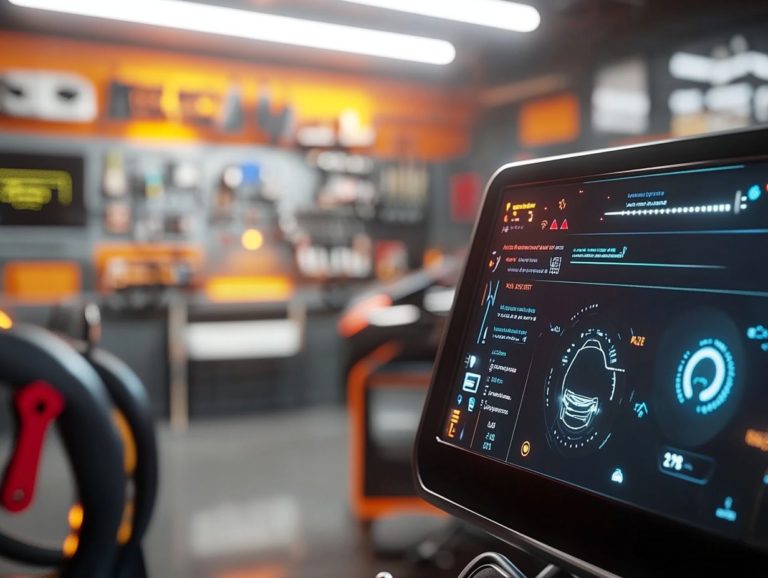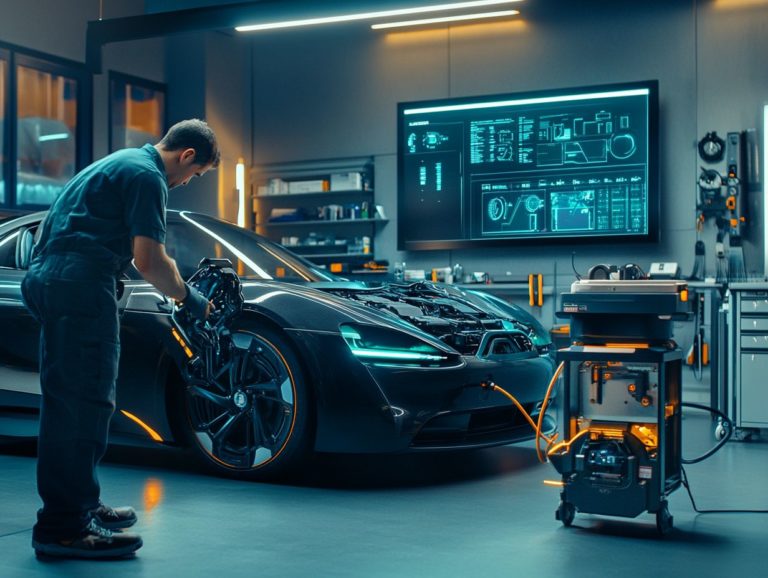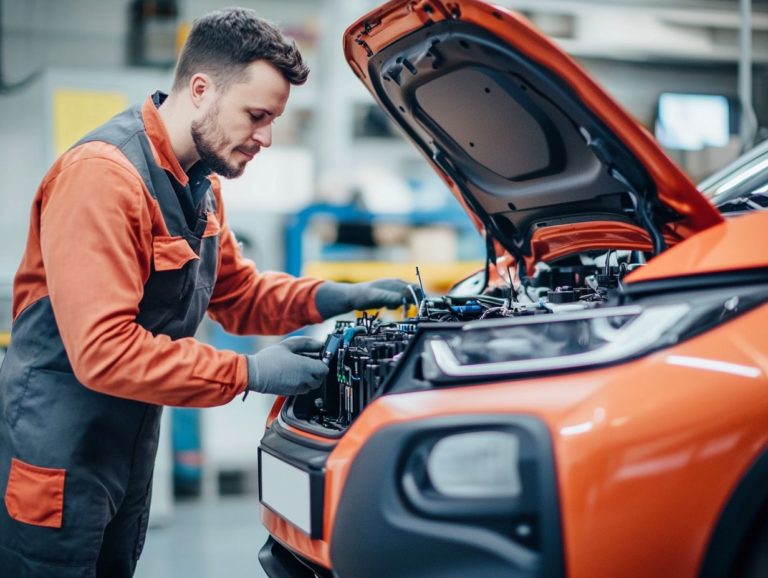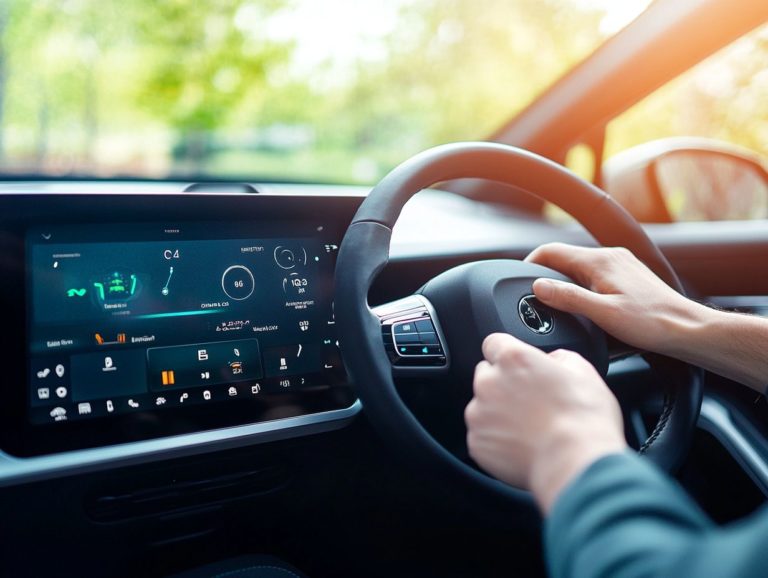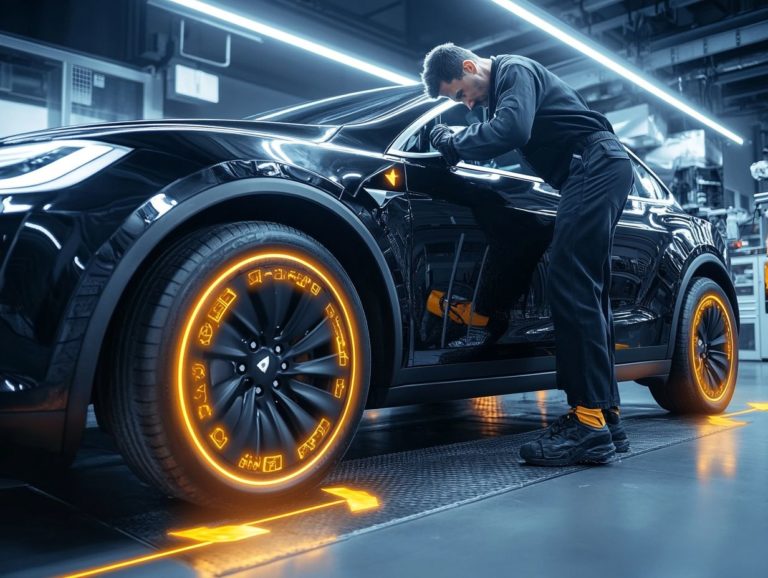Essential Resources for EV Maintenance
Maintaining your electric vehicle (EV) is essential for achieving best performance and extending its lifespan. From charging stations to important maintenance tools, each resource contributes significantly to keeping your vehicle running seamlessly.
Here are 15 key items that every EV owner should have readily available, along with insights on how frequently these resources should be checked or replaced. Whether you re just embarking on your EV journey or you re a seasoned pro, this guide is your roadmap to keeping your vehicle thriving don t miss out!
Contents
- Key Takeaways:
- 1. Charging Stations
- 2. Battery Maintenance Tools
- 3. Tire Pressure Gauge
- 4. Windshield Wiper Fluid
- 5. Car Wash Kit
- 6. Brake Pads and Rotors
- 7. Motor Oil and Filter
- 8. Coolant
- 9. Brake Fluid
- 10. Spark Plugs
- 11. Air Filter
- 12. Transmission Fluid
- 13. Headlights and Taillights
- 14. Emergency Kit
- 15. Owner’s Manual
- How Often Should These Resources Be Checked or Replaced?
- Frequently Asked Questions
Key Takeaways:
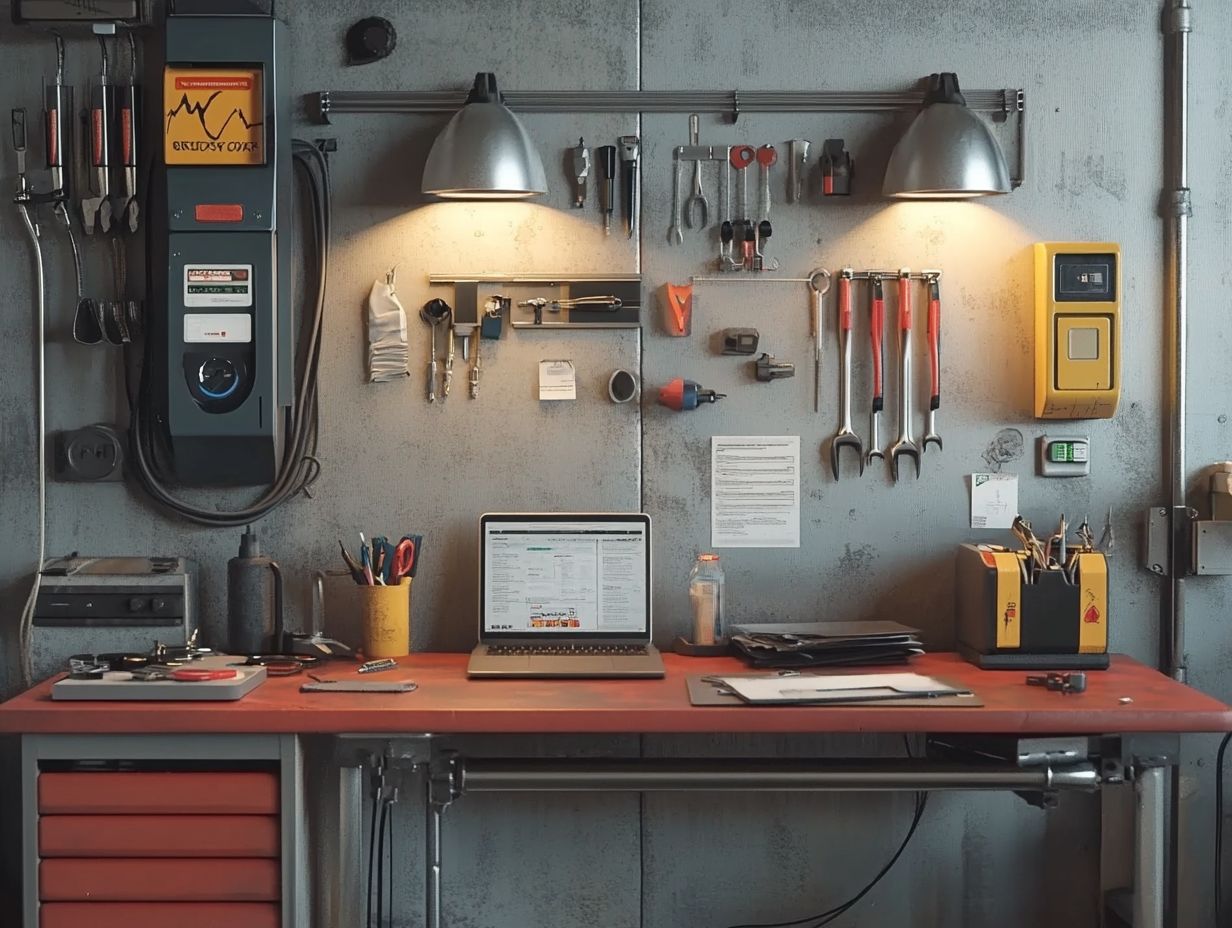
- Regularly check and maintain battery, tire pressure, and fluid levels to ensure best performance and longevity of your EV.
- Invest in a car wash kit and windshield wiper fluid for proper exterior maintenance and visibility.
- Be prepared for emergencies with an emergency kit and refer to your owner’s manual for recommended maintenance schedules and procedures.
1. Charging Stations
Charging stations are essential for your electric vehicle (EV) ownership journey. They enable you to recharge your vehicle’s batteries conveniently and efficiently, ensuring best performance.
As the adoption of electric vehicles continues to rise, the significance of strategically placing charging stations becomes ever more pronounced, forming the backbone of a thriving electric vehicle ecosystem.
Among the various types of charging stations, Level 1 chargers, often found in residential areas, offer a straightforward solution just plug in overnight. Level 2 chargers, typically located in public spaces, provide faster charging times and are crucial for urban environments where EV usage is booming. DC fast chargers charge your vehicle much quicker than regular chargers, making them ideal for long trips or busy days.
Accessibility plays a direct role in your decision to transition from traditional gas-powered vehicles, which often come with higher maintenance costs. In contrast, less frequent charging translates to lower ownership expenses over time, making an EV not just a sustainable choice but also a savvy financial decision.
2. Battery Maintenance Tools
Utilizing the right battery maintenance tools is essential for your electric car’s upkeep. These tools not only prolong battery life but also ensure you stay compliant with warranty requirements. For more information, check out understanding EV electronics and maintenance.
You ll find a variety of devices among these tools, including battery testers, voltmeters, and thermal cameras each meticulously designed to evaluate different aspects of battery performance. For example, battery testers can assess the state of charge and health.
Monitoring these elements allows for early detection of issues, underscoring the importance of a proactive approach to battery service. By establishing regular maintenance routines, you can significantly enhance your battery’s longevity, minimize the frequency of replacements, and optimize your vehicle’s overall efficiency.
3. Tire Pressure Gauge
A tire pressure gauge is an essential tool for your tire care routine, playing a pivotal role in maintaining your electric vehicle and ensuring optimal performance by keeping your tire pressure just right.
Regularly checking your tire pressure not only boosts safety but also enhances your overall driving experience. For electric vehicles, which thrive on precise calculations for range and energy efficiency, the importance of keeping tires inflated to the manufacturer’s recommended levels is crucial.
Under-inflated tires can cause increased rolling resistance, leading to faster battery depletion, while over-inflation can compromise your vehicle s traction. By routinely monitoring your tire pressure, you can ensure that your electric vehicle performs at its peak while adhering to safety standards, ultimately making every journey safer and more economical.
Ready to maximize your EV’s performance? Start by gathering these essential tools today!
4. Windshield Wiper Fluid
Windshield wiper fluid is an important part of your maintenance routine for electric vehicles. It not only ensures clear visibility but also helps keep your electric car in great shape.
Maintaining proper fluid levels is crucial for visibility and meeting safety regulations. A clear view during heavy rain or snow can make the difference between a safe journey and a dangerous one.
There are different types of windshield wiper fluids designed for various weather conditions. Summer solutions repel dirt and grime, while winter blends prevent freezing. By choosing the right type for your driving conditions, you can enhance your safety on the road and extend the life of your wiper blades. Keep your electric vehicle running smoothly!
5. Car Wash Kit
A car wash kit is key to keeping your electric vehicle looking pristine. It enhances its aesthetic appeal and protects important components.
Regular cleaning preserves that glossy finish and prevents dirt from settling in critical areas, which can lead to corrosion over time. A good kit usually includes pH-balanced soap, microfiber towels, and a tire cleaning brush specifically tailored for electric vehicles.
You might also find products made for sensitive surfaces to keep delicate sensors and charging ports fully functional. Using these tools consistently helps improve your vehicle’s performance and longevity.
6. Brake Pads and Rotors
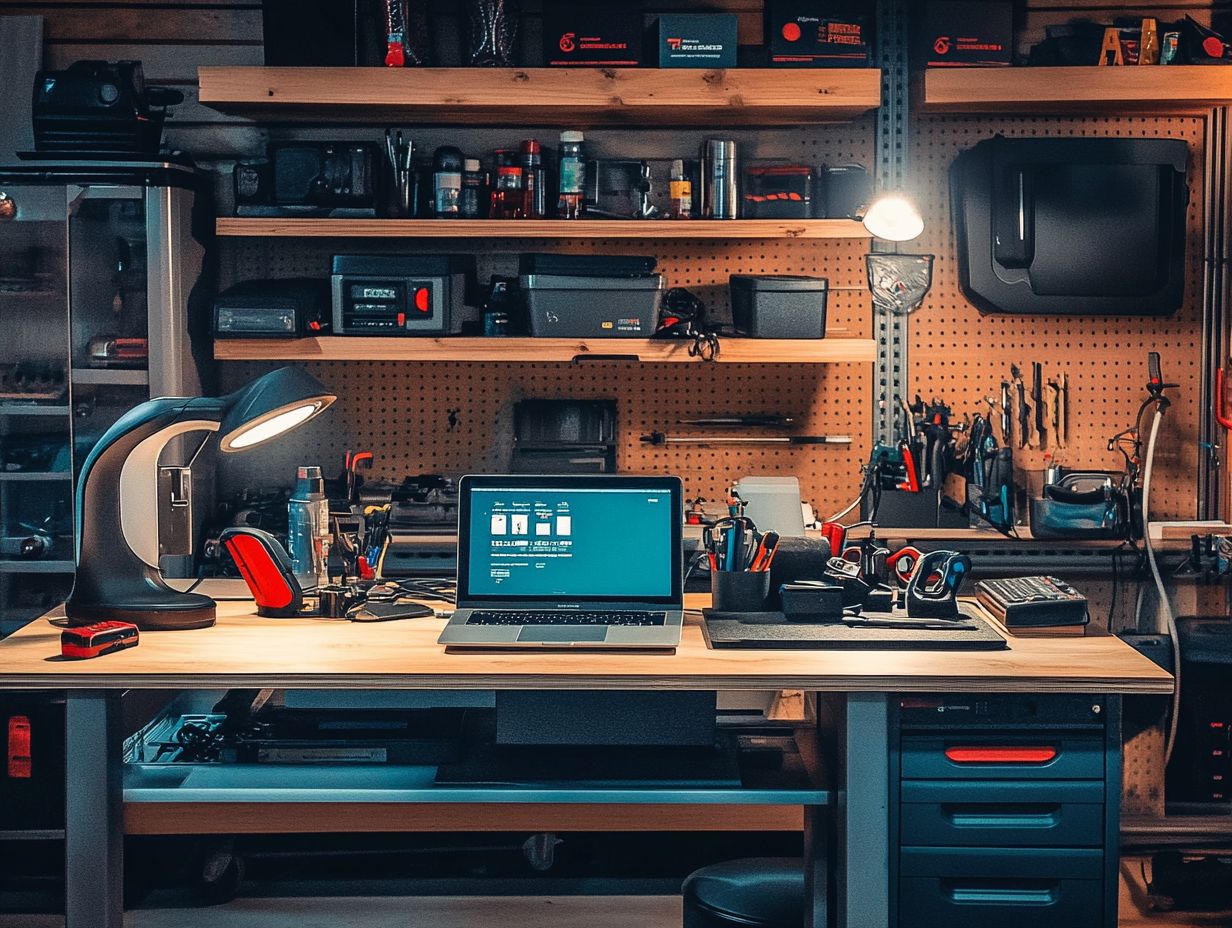
Regularly checking and maintaining your brake pads and rotors is vital for your electric vehicle. This is especially important because of regenerative braking systems, which use the car’s movement to generate energy and recharge the battery.
Unlike traditional cars that rely solely on friction, electric vehicles use this technology to reduce wear on brake pads. However, you still need to keep up with maintenance to ensure excellent performance.
The wear patterns of electric vehicles call for a tailored maintenance approach. It s essential to know when to check the components and understand the specific signs of wear. By following recommended maintenance schedules, you can avoid unexpected issues and extend the lifespan of your braking system and vehicle.
7. Motor Oil and Filter
Electric vehicles don’t use traditional motor oil like gas-powered cars, but understanding motor oil and filters is necessary for hybrid systems.
In a plug-in hybrid electric vehicle, the internal combustion engine still requires regular attention to its motor oil and filter for peak performance. Check the oil at least every 5,000 to 7,500 miles, or follow the manufacturer’s guidelines.
Monitoring fluid levels is crucial for engine health and the overall efficiency of your vehicle. This contrasts with fully electric vehicles, which run solely on batteries and don t need oil changes or filter replacements. As a hybrid driver, you ll navigate a unique blend of traditional and modern maintenance practices.
8. Coolant
Coolant is a vital fluid for your electric vehicle. It plays a key role in maintaining the best temperature management during operation and contributes to the overall maintenance and reliability of your car.
This fluid prevents overheating, especially in high-voltage systems where components generate significant heat during use. By ensuring consistent temperature regulation, the coolant protects sensitive electronic parts and enhances their performance.
Don’t forget to check your coolant levels! It s key to keeping your vehicle running smoothly. Inadequate amounts can lead to system failures, costly repairs, or diminished efficiency.
To keep your car’s cooling system in peak condition, prioritize these tasks:
- Make it a habit to check your hoses for leaks,
- Flush the system periodically, and
- Replace the coolant according to the manufacturer s schedule.
By doing so, you can ensure the longevity and reliability of your vehicle.
9. Brake Fluid
Check your brake fluid regularly to ensure safety. It’s essential for keeping your electric vehicle’s braking system in top shape, ensuring that safety and performance remain uncompromised during your drives.
Given the unique components of electric vehicles, this routine monitoring becomes even more critical. To assess your brake fluid levels, locate the reservoir, typically found near the back of the engine compartment. Ensure the fluid sits within the appropriate range marked on the container.
The quality of your brake fluid directly impacts the responsiveness of your braking system. Old or contaminated fluid can lead to brake failure a risk that affects both electric and gas-powered vehicles. Electric cars may require a specific viscosity, which is the thickness of the fluid that affects its performance, highlighting the importance of following manufacturer recommendations for optimal maintenance.
Check it now to avoid safety risks during your next drive!
10. Spark Plugs
While electric vehicles don t utilize spark plugs, grasping their function in gas-powered cars offers valuable insights into the maintenance distinctions between gas and electric vehicles.
Spark plugs ignite the air-fuel mixture in the combustion chamber, playing a pivotal role in engine performance and efficiency. Over time, they can wear out or become fouled, resulting in issues such as misfiring, increased emissions, and diminished fuel economy. This necessitates regular maintenance schedules for gas-powered vehicles, often requiring spark plug replacements every 30,000 to 100,000 miles, depending on the type of spark plug installed.
In contrast, electric cars operate on a fundamentally different mechanism, relying on electric motors and batteries. This significantly reduces the frequency of maintenance tasks, shifting the focus to ensuring that battery systems and charging components remain in optimal condition.
11. Air Filter
The air filter is an essential element in maintaining your electric vehicle. It ensures clean air circulation for its systems and boosts overall performance.
Its significance truly cannot be overstated, as it directly influences the efficiency of cooling systems and minimizes wear on sensitive electronic components. Regularly checking and replacing this filter not only helps maintain optimal performance but also contributes to your vehicle s longevity.
Unlike gas-powered cars, where air filters mainly focus on the combustion process, electric vehicles rely on clean air for various systems, including battery cooling and cabin air quality. Therefore, neglecting this small yet crucial component can lead to decreased performance and potential costly repairs down the line.
12. Transmission Fluid
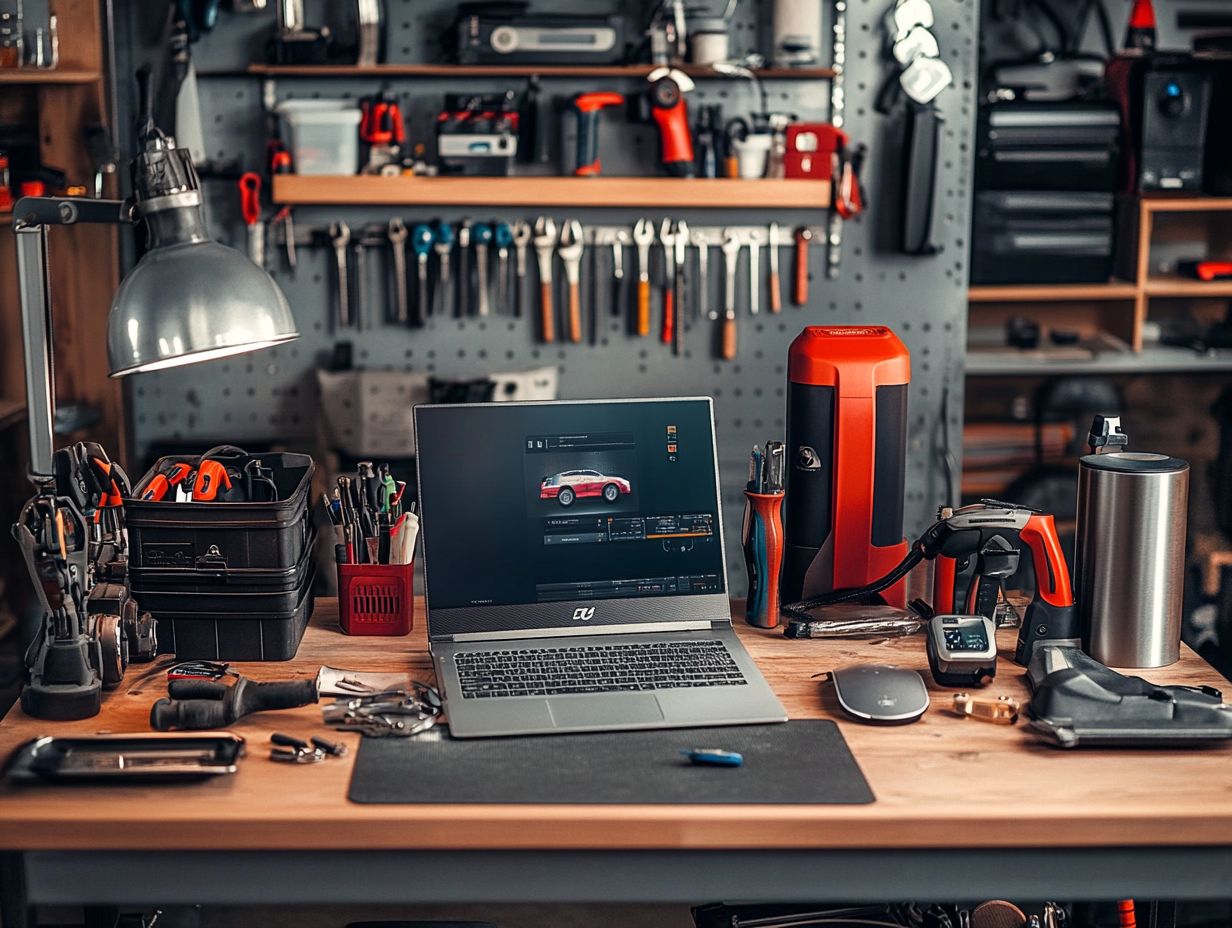
Transmission fluid plays a vital role in your electric car maintenance, especially in hybrid electric systems. Effective fluid assessments can markedly improve vehicle performance.
In electric vehicles, the transmission fluid does more than just lubricate moving parts. It also helps regulate temperature and ensures seamless energy delivery between the electric motor and the drive wheels.
Unlike traditional vehicles, where fluid must accommodate complex gear shifts and numerous moving components, the fluid in electric systems is often more simplified, thanks to the simpler design of electric drivetrains.
Regular checks and timely fluid replacements are essential for optimal operation. Neglecting this maintenance can decrease efficiency and potentially damage your drivetrain components. Prioritize this aspect of your vehicle care to keep everything running smoothly.
13. Headlights and Taillights
Maintaining your headlights and taillights is crucial for ensuring safety in your electric vehicle. This guarantees visibility and adherence to road safety regulations.
Regularly checking and replacing these lights is vital. Dim or malfunctioning lights can significantly elevate the risk of accidents, especially in low-light conditions or adverse weather.
This practice is part of the broader scope of electric car maintenance. Consistently monitoring all components promotes optimal performance and longevity.
To effectively maintain your lighting systems, consider the following recommendations:
- Inspect your lights every few months.
- Wipe the lenses to keep them bright.
- Replace bulbs promptly when they show signs of wear.
By embracing these best practices, you can enhance your safety on the road and ensure that your electric vehicle operates smoothly!
14. Emergency Kit
Having an emergency kit is essential for you as an electric vehicle owner! It equips you with the tools and supplies needed to tackle unexpected situations on the road.
Given the unique challenges you might encounter, make sure your kit has a portable charging station. It s good for those times when charging stations are hard to find!
A tire repair kit and a jump starter specifically designed for electric vehicles are crucial, ready to assist you in the event of flat tires or battery issues.
Plus, along with basic roadside assistance items like a first aid kit and flashlight, don t forget to include a reflective warning triangle. This enhances your safety during breakdowns, especially in low-light conditions.
Also, consider adding an EV-specific user manual and contact information for roadside services. These will help you navigate any unforeseen predicaments with ease and confidence, especially if you refer to how to keep track of your EV’s maintenance.
15. Owner’s Manual
The owner’s manual is an invaluable resource for your electric vehicle maintenance. It lays out essential tasks, vehicle software updates, and guidelines, including understanding EV regulations and maintenance to ensure optimal performance.
Typically, it includes sections on safety information, troubleshooting tips, and a comprehensive overview of your vehicle s features and controls.
Make it a habit to glance through your manual often! By consulting it regularly, you can gain a deeper understanding of your electric vehicle, facilitating better upkeep over time.
The manual highlights specific maintenance schedules that are vital for the longevity of critical components such as the battery and brakes.
Frequent reference not only helps you address potential issues before they escalate but also gives you the peace of mind that you re adhering to the manufacturer s recommendations for a seamless driving experience.
How Often Should These Resources Be Checked or Replaced?
Establishing a regular maintenance schedule for your electric vehicle is essential. It ensures that all critical parts are checked and replaced as necessary, ultimately lowering your maintenance costs while enhancing safety and performance. For more details, refer to our guide on understanding different EV maintenance needs.
For instance, you should consider:
- Inspecting the battery and performing software updates every six months.
- Assessing tire condition and alignment every 5,000 to 7,500 miles.
- Regular brake inspections at least once a year.
These timely checks can significantly boost battery longevity and vehicle efficiency. Additionally, adopting a proactive approach to maintenance helps extend your electric vehicle’s lifespan. You’ll enjoy a smoother, hassle-free ride that keeps you on the road longer!
Frequently Asked Questions
What are essential resources for EV maintenance?
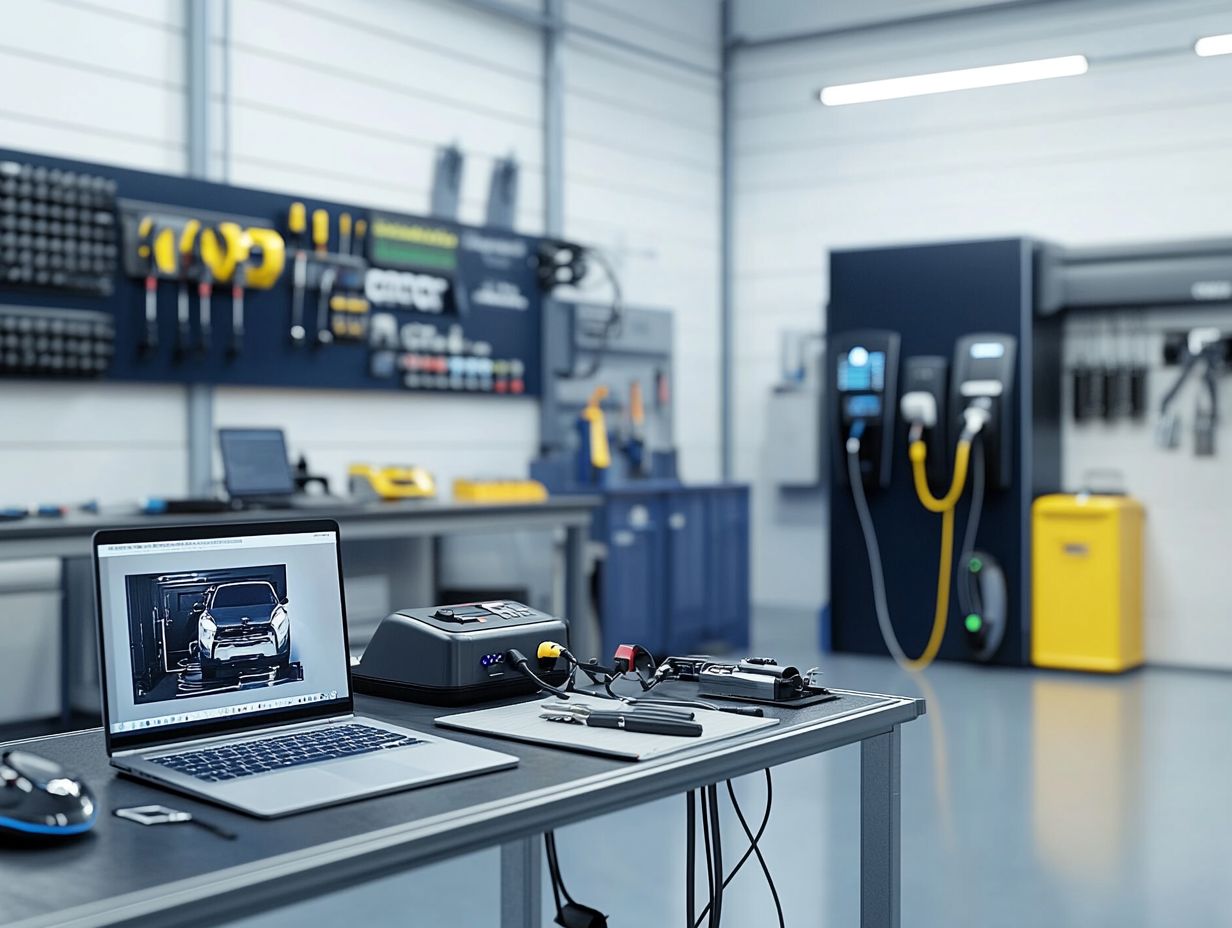
Essential resources for EV maintenance include specialized tools, software, instructional guides, and essential tools for EV maintenance at home, as well as access to EV charging stations.
Where can I find instructional guides for EV maintenance?
You can find EV maintenance guides on manufacturer websites, forums, and specialized EV sites.
Do I need specialized tools for EV maintenance?
Yes, specialized tools are necessary for maintaining and repairing EVs, as they have different parts and systems compared to traditional vehicles. Knowing how to handle EV maintenance emergencies can also be crucial for effective care.
What software is needed for EV maintenance?
Software that can diagnose and monitor EV performance and provide updates and maintenance recommendations is essential for understanding EV maintenance costs.
How do I access EV charging stations?
EV charging stations can be accessed through public charging stations, at-home charging units, and workplace charging options.
Are there any additional resources for EV maintenance?
In addition to specialized tools and software, resources such as online communities and workshops, along with training programs for EV owners, can also be useful for EV maintenance.

